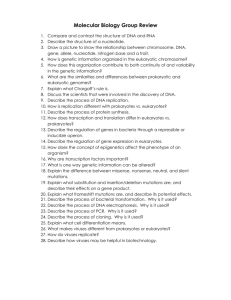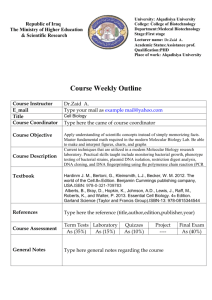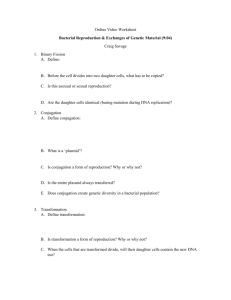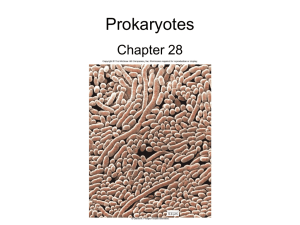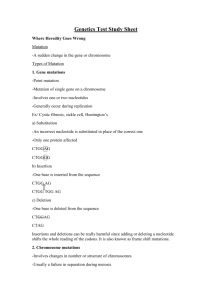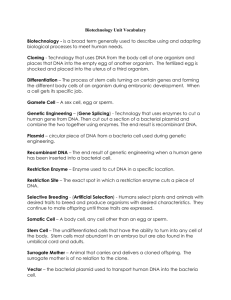Reading GuideGeneTransfer
advertisement
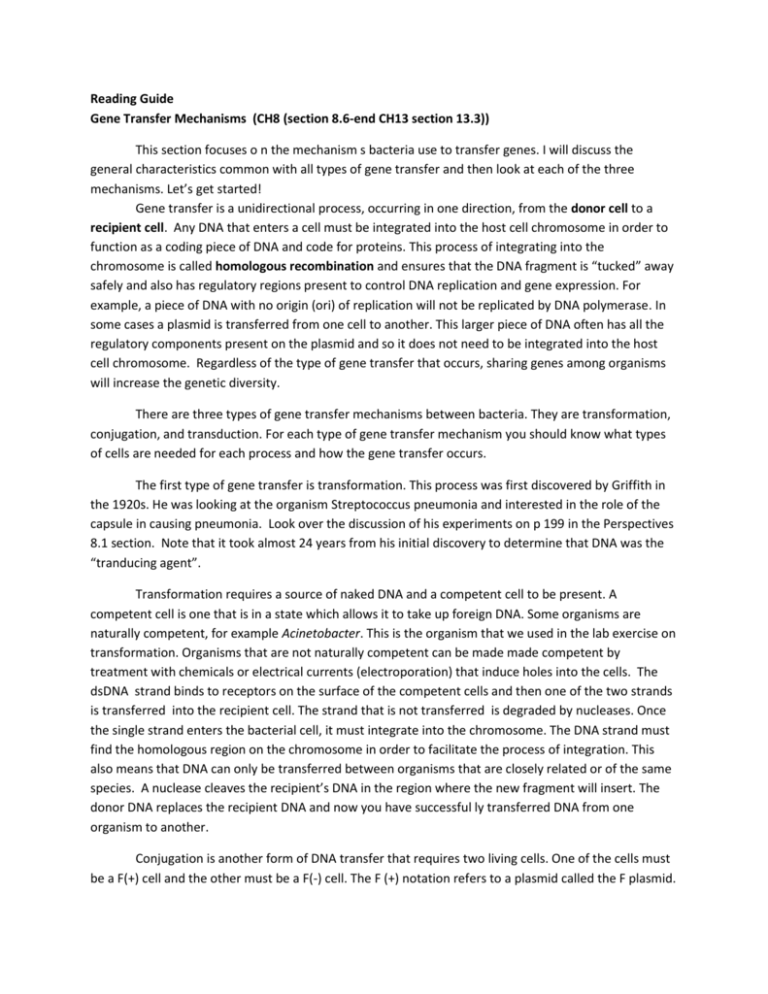
Reading Guide Gene Transfer Mechanisms (CH8 (section 8.6-end CH13 section 13.3)) This section focuses o n the mechanism s bacteria use to transfer genes. I will discuss the general characteristics common with all types of gene transfer and then look at each of the three mechanisms. Let’s get started! Gene transfer is a unidirectional process, occurring in one direction, from the donor cell to a recipient cell. Any DNA that enters a cell must be integrated into the host cell chromosome in order to function as a coding piece of DNA and code for proteins. This process of integrating into the chromosome is called homologous recombination and ensures that the DNA fragment is “tucked” away safely and also has regulatory regions present to control DNA replication and gene expression. For example, a piece of DNA with no origin (ori) of replication will not be replicated by DNA polymerase. In some cases a plasmid is transferred from one cell to another. This larger piece of DNA often has all the regulatory components present on the plasmid and so it does not need to be integrated into the host cell chromosome. Regardless of the type of gene transfer that occurs, sharing genes among organisms will increase the genetic diversity. There are three types of gene transfer mechanisms between bacteria. They are transformation, conjugation, and transduction. For each type of gene transfer mechanism you should know what types of cells are needed for each process and how the gene transfer occurs. The first type of gene transfer is transformation. This process was first discovered by Griffith in the 1920s. He was looking at the organism Streptococcus pneumonia and interested in the role of the capsule in causing pneumonia. Look over the discussion of his experiments on p 199 in the Perspectives 8.1 section. Note that it took almost 24 years from his initial discovery to determine that DNA was the “tranducing agent”. Transformation requires a source of naked DNA and a competent cell to be present. A competent cell is one that is in a state which allows it to take up foreign DNA. Some organisms are naturally competent, for example Acinetobacter. This is the organism that we used in the lab exercise on transformation. Organisms that are not naturally competent can be made made competent by treatment with chemicals or electrical currents (electroporation) that induce holes into the cells. The dsDNA strand binds to receptors on the surface of the competent cells and then one of the two strands is transferred into the recipient cell. The strand that is not transferred is degraded by nucleases. Once the single strand enters the bacterial cell, it must integrate into the chromosome. The DNA strand must find the homologous region on the chromosome in order to facilitate the process of integration. This also means that DNA can only be transferred between organisms that are closely related or of the same species. A nuclease cleaves the recipient’s DNA in the region where the new fragment will insert. The donor DNA replaces the recipient DNA and now you have successful ly transferred DNA from one organism to another. Conjugation is another form of DNA transfer that requires two living cells. One of the cells must be a F(+) cell and the other must be a F(-) cell. The F (+) notation refers to a plasmid called the F plasmid. This plasmid consists of genes to build or synthesize a sex pilus and to facilitate transfer of the plasmid. The process of conjugation begins when a F (+) cell binds( using the sex pilus) to a F(-) cell. The F plasmid is cut by an endonuclease at a site on the plasmid called of the origin of transfer, this is where transfer of the plasmid begins. One strand of the plasmid is transferred through the sex pilus, when it enters the recipient cell a complementary strand is made. When the process is finished the F(-) cell will be now a F(+) cell since it has the F plasmid. In some circumstances the F plasmid integrates into the chromosome of the host cell. Cells that have the F plasmid in the chromosome are called Hfr cells to indicate they differ from F(+) cells. Keep in mind that an Hfr cell can still make a sex pilus and will cut the plasmid and transfer just like in a F(+) cell. The difference is that when the plasmid is integrated into the chromosome and begins the transfer process, the entire F plasmid cannot be transferred unless the entire chromosome is transferred. When the cells are connected via the sex pilus they can transfer genes at a rate of 30-40 genes/minute and stay together for about 8-9 minutes. This is not long enough to transfer all the chromosomal genes (this would take 100 minutes to accomplish!) and subsequently the rest of the F plasmid is not transferred into the host cell. What does this mean for the recipient cell??? Well…they don’t get the entire F plasmid, so they can’t make a sex pilus, they aren’t F(+) but remain F(-), and they may acquire a few new genes if they integrate the fragment of DNA into their chromosome. One last situation in conjugation occurs when an Hfr cell excises the F plasmid from the chromosome and in doing so accidently takes a small fragment of the bacterial chromosome with it. This F plasmid now contains a few bacterial chromosomal genes and cells with this form of the F plasmid are called F’ cells (F prime). When these cells conjugate with a F(-) cell the F plasmid is transferred (just like in F(+) cells and the recipient cell will receive additional chromosomal genes…the ones that were attached to the part of the F plasmid. The last type of gene transfer is transduction. This type of gene transfer requires that a bacterial cell and phage be present. There are two different kinds of transduction, generalized transduction and specialized transduction. In generalized transduction, the phage involved in the process is a lytic phage. When the phage infects the bacterial cell and replicates to make new viruses it can accidently package a piece of bacterial chromosomal DNA in the capsid. When this happens the entire capsid contains only bacterial DNA and no phage DNA. When this phage is assembled and released it is still capable of functioning like a phage and will bind to new bacterial cells. When the phage inserts the nucleic acid into the bacterial cell, the nucleic acid is only bacterial DNA and so there will not be any new virions produced. The bacterial cell will only receive a “headfull” or “capsid-full” amount of bacterial DNA. Note that this process of generalized transduction will only occur when phage enter the lytic cycle. Virulent as well as lysogenic phage can move genes by this process. Specialized transduction occurs when a lysogenic phage integrates into the bacterial chromosome. Remember that in this state the phage is called a prophage. Let’s use lambda as an example of the process of specialized transduction…..so when lambda integrates into the bacterial chromosome, remember it will integrate in between the gal gene and the bio gene. If when the phage excises itself from the chromosome it accidently takes some of the bacterial DNA on either side of the insertion, you now have a phage with mostly phage DNA and a few bacterial genes. When this phage leaves the cell and infects a new bacterial cell, it will bring with it the phage DNA/bacterial DNA material. This phage DNA does not have all the genes to make new phages….since some were left in the bacterial chromosome when the phage excised itself. This nucleic acid will not code for any new viruses and so if the phage DNA is integrated into the chromosome of this new bacterial cell, the integration of bacterial DNA from the previous cell will occur……does this make sense??? This is where you have the gene transfer from one bacterial cell to another via a phage! One last section I would ask you to review is section 8.9 on the mobile gene pool. In this section you are introduced to plasmids, in particular R plasmids. These are plasmids which contain a collection of antibiotic resistance genes AS well as the genes for synthesis of a sex pilus and transfer……which means that these plasmids can be transferred between bacteria by conjugation just like F plasmids. The section on transposons features a follow up on a real-life example of how resistance to vancomycin was transferred to a S. aureus generating a strain of S. aureus that was resistant to vancomycin. How did the organism acquire the vancomycin resistant gene??? What does this suggest about the use of antibiotics and the development of bacterial resistance??
